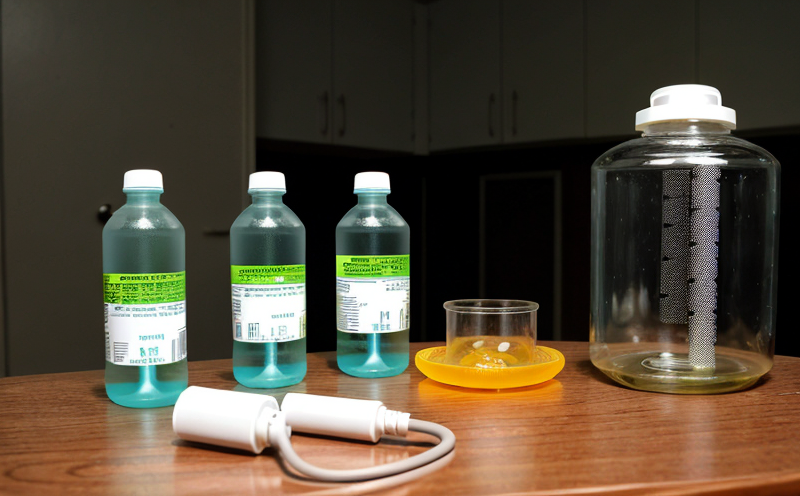ISO 9697 Gross Beta Radioactivity Test in Water
The ISO 9697 standard specifies a method for determining gross beta radioactivity in water samples. This test is crucial for ensuring the safety and quality of drinking water, wastewater, and other aqueous environments by identifying radioactive contaminants that may pose health risks to humans or wildlife.
Water bodies can become contaminated with radionuclides through various pathways, including natural processes like weathering of rocks, anthropogenic activities such as nuclear testing, industrial discharges, and improper waste disposal. The presence of beta-emitting radionuclides in water is particularly concerning due to their potential for causing cellular damage at relatively low doses.
The ISO 9697 method involves a series of steps designed to accurately measure gross beta activity without distinguishing between different isotopes or specific radionuclides. This approach ensures that all beta-emitting radionuclides are accounted for, providing a comprehensive assessment of the radioactivity levels in water samples.
The testing process begins with the collection and preparation of water samples. These samples must be representative of the source being tested to ensure accurate results. Proper sample handling is critical to avoid contamination or loss of radioactive materials during transport and storage.
Once collected, the water samples are typically filtered through a specified filtration media designed to retain beta-emitting radionuclides while allowing other components to pass through. The filter retains the radionuclides, which can then be measured for their radioactivity content using specialized instrumentation.
The measurement of gross beta activity is performed using low-background beta counters or similar equipment capable of detecting very small amounts of radiation. These instruments are calibrated regularly to ensure accuracy and precision in measurements. The testing process involves placing the filtered samples into the instrument, where they are exposed for a specified period to allow sufficient counting statistics.
The results obtained from this test provide quantitative data on the gross beta radioactivity levels present in the water sample. This information is crucial for regulatory compliance, environmental monitoring, and public health protection. Compliance with established limits for beta-emitting radionuclides helps ensure that drinking water meets safety standards set by international organizations such as WHO (World Health Organization).
Understanding the significance of gross beta radioactivity testing in relation to broader water quality issues highlights its importance in safeguarding human health and environmental integrity. By adhering to internationally recognized standards like ISO 9697, laboratories play a vital role in maintaining high-quality standards for water safety.
Applied Standards
The ISO 9697 standard is widely used globally due to its robustness and reliability. It ensures consistency across different testing environments, making it an essential tool for laboratories worldwide. This international standard provides clear guidelines on sample preparation, measurement techniques, and data interpretation.
- ISO 9697-1: General principles and sampling procedures.
- ISO 9697-2: Methods using liquid scintillation counting.
- ISO 9697-3: Methods using proportional counters.
These subparts offer flexibility depending on the specific requirements and available resources of individual laboratories. Compliance with these standards ensures that results are comparable across different testing facilities, enhancing confidence in regulatory compliance efforts.
In addition to ISO 9697, other relevant international standards include:
- ASTM D3851: Standard test method for gross beta activity of water by liquid scintillation counting.
- EN 14024-1: Determination of radionuclides in water - Part 1: General principles and sampling procedures.
The integration of these standards into routine testing protocols helps maintain a high level of accuracy and reliability, which is essential for effective quality management and sustainable practices.
Environmental and Sustainability Contributions
The ISO 9697 gross beta radioactivity test plays a significant role in environmental protection by helping identify potential sources of contamination that could harm ecosystems. By monitoring water bodies for beta-emitting radionuclides, this testing contributes to the overall goal of sustainable development.
Water quality is closely linked to human health and ecosystem balance. Detecting and controlling gross beta radioactivity levels can prevent harmful effects on both humans and aquatic life. Regular testing allows authorities to take proactive measures to mitigate risks associated with radioactive contamination.
Incorporating ISO 9697-compliant testing into routine environmental monitoring programs enhances the effectiveness of regulatory frameworks aimed at protecting water resources. This approach supports broader sustainability goals by fostering a safer, healthier environment for future generations.
By adhering to international standards and best practices in water testing, laboratories contribute significantly to global efforts toward sustainable development. Their role is pivotal in ensuring that water sources remain safe and clean, thereby supporting broader environmental health initiatives.
Use Cases and Application Examples
- Drinking Water Supply Monitoring: Regular testing helps ensure compliance with international standards for drinking water quality.
- Wastewater Treatment Plants: Ensures that treated effluents meet safety criteria before discharge into natural water bodies.
- Nuclear Power Plant Operations: Monitors the release of beta-emitting radionuclides from plant operations to protect public health.
- Environmental Impact Assessments: Provides data for evaluating potential impacts on aquatic ecosystems due to industrial activities or natural disasters.
- Public Health Studies: Assists in tracking trends and identifying sources of radioactive contamination affecting human populations.
- Agricultural Water Management: Ensures that irrigation water used in agricultural practices does not pose risks to crop yields or food safety.
The ISO 9697 gross beta radioactivity test is a cornerstone of comprehensive quality management systems, providing essential data for decision-making processes across various sectors. Its application ensures that water resources are protected and managed sustainably, contributing to the overall health and well-being of communities worldwide.





